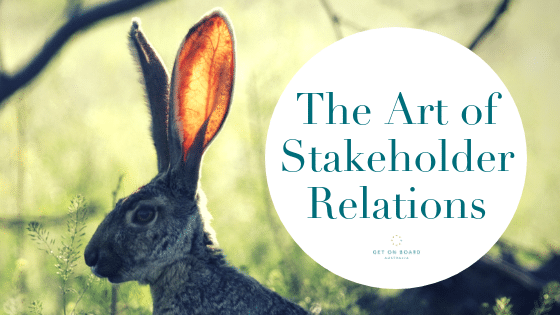The Art of Stakeholder Relations for Better Business Outcomes

Depending on your organisation, stakeholder relations can mean a light touch with a couple of small groups of people, or to a large organisation it means ensuring certain stakeholders are receiving certain information at a specific time and at mandatory intervals driven largely by the organisation’s legal requirements.
Regardless of the type of organisation, when proactive and ongoing stakeholder relations are running with ease, you’ll be doing less fire-fighting with fewer interruptions. You’ll be proactively managing issues before they arise, rather than putting out fires as they occur.
So where do you start your stakeholder relations, particularly if you’ve never heard of ‘stakeholders’ before? Let’s start at the beginning and go from there…
Who are your stakeholders?
Every organisation has stakeholders. They are the people or groups of people who fit the following audiences:
• Customers
• Staff
• Volunteers
• Suppliers
• Government / Regulators
• Funders / Donors / Sponsors
• The Community
• The Board
• Shareholders / Investors
A shorthand rule of thumb is to think of a stakeholder as anyone who can be, or is, impacted by the activities of the organisation.
Why you need stakeholder relations
Stakeholder engagement supports both the board and the management to be prepared and able to detect, assess and manage any change in the organisation’s societal environment that may prove to be critical for the organisation’s strategy and its capacity to implement it.
Essentially, stakeholder relations provide an avenue for feedback from the organisation’s community about any concerns about the things (i.e. delivering services, manufacturing products, etc.) the organisation is doing (and sometimes not doing). It is also an avenue for the organisation to proactively – or reactively – communicate to its various audiences (in whole or part).
Social media has enabled stakeholders to engage with organisations instantly and bring concerns to their attention in real time and in a very public forum. This is great for a customer service perspective; however, we usually hear about stakeholder relations when there is an organisational crisis. Think, BP’s Deepwater Horizon explosion and oil spill, or Target Australia’s apparent bottled water price-hike after Cyclone Debbie.
Thankfully, stakeholder relations isn’t only all about managing crises. Proactive stakeholder relations opens the opportunity for organisations to engage with customers, staff, suppliers, and others in meaningful ways that can lead to improved organisation and community outcomes. Think new or improved services and/or products, more environmentally-friendly operating methods, engaged audiences promoting your products / services, more secure funding, increased donors, and opens the door to potential business opportunities.
Do you need it?
Although the above examples demonstrate stakeholder relations in large organisations, what organisation – regardless of size – wouldn’t want all of those positive outcomes?!?
For some larger organisations, they are legally required to provide regular communications (or ‘disclosures’) to their stakeholders (primarily their shareholders and the ‘marketplace’). CEO of Rhetoric PR and contributor to Boardroom Bootcamp, Jenny Hassam, believes that smaller organisations can benefit from some degree of stakeholder engagement.
“The minimum an organisation should have is a brief Stakeholder Communications Strategy so the board is clear on who the organisation’s stakeholders are, how often they should be communicated to, and what relevant information should be shared with them based on their relationship with the organisation.”
How to do it.
This simple yet powerful approach outlined above by Jenny is something that all boards could do in a short session around the boardroom table and maintained in a simple spreadsheet. However, Jenny recommends adopting a more in-depth process when the message is significant and/or could be met with some degree of public opinion (for example, redundancies, a significant change of operations, or – something more positive – a new service offering or partnership).
“Take the time to analyse the communication requirements of each stakeholder group and the timing around the communications. Map out who is going to be told what, and when they will be communicated to. You may even want to include the communication platform to be used (e.g. email, social media, telephone, face-to-face, etc.) so everything can be planned and prepared in advance as much as possible.”
Keep the ball rolling
Stakeholder engagement is mostly about listening and communicating. It’s establishing an open dialogue with the various communities of the organisation to ensure a continuous information flow that addresses the needs of each audience. It should happen at all levels of an organisation and can use formal (e.g. surveys, focus groups) and informal (e.g. social media, chatting with a client) methods.
Westpac have a fantastic stakeholder engagement framework. It reinforces that the “… method of engagement will vary depending on the stakeholder, the issues of concern and the purpose of engagement, and will be best selected to meet the needs, capacity and expectations of the relevant stakeholders.”
This framework can be easily adapted for any sized organisation. Westpac make sure to also include measurement metrics to quantify the organisational returns from investing in stakeholder engagement.
I hope this introduction to stakeholder relations helps your organisation to adopt a purposeful and proactive approach to engaging with your various audiences to achieve better business outcomes. As Daniel Pink put it, “Treat everyone as you’d treat your grandmother, but assume that Grandma has eighty thousand Twitter followers” [from To Sell is Human].
